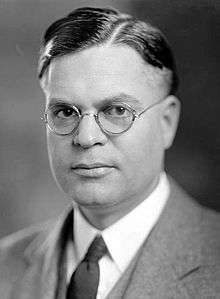Royal C. Johnson
| Royal C. Johnson | |
|---|---|
 | |
| Member of the U.S. House of Representatives from South Dakota's 2nd district | |
|
In office March 4, 1915 – March 3, 1933 | |
| Preceded by | Charles H. Burke |
| Succeeded by | Theodore B. Werner |
| Attorney General of South Dakota | |
|
In office 1911–1915 | |
| Preceded by | S. W. Clark |
| Succeeded by | Clarence C. Caldwell |
| Personal details | |
| Born |
Royal Cleaves Johnson October 3, 1882 Cherokee, Iowa |
| Died |
August 2, 1939 (aged 56) Washington, D.C. |
| Political party | Republican |
| Alma mater | University of South Dakota School of Law |
| Profession | Attorney |
Royal Cleaves Johnson (October 3, 1882 – August 2, 1939) was a Republican member of the United States House of Representatives from South Dakota and a highly decorated veteran of World War I. He was born in Cherokee, Iowa in 1882.
Early life, education, and career
He moved with his parents to Highmore, South Dakota in 1883, and attended the public schools. He graduated from the University of South Dakota School of Law in 1906, and was admitted to the bar that same year. He started his practice in Highmore. He became the assistant state's attorney for Hyde County in 1906, and State's Attorney in 1908 and 1909. In 1910, he became the Attorney General of South Dakota. In 1913, he moved to Aberdeen, South Dakota and returned to private practice. He was elected to the United States House of Representatives in 1915, serving through the end of the Seventy-Second Congress in 1932. He was the chairman for the Committee on Expenditures in the Department of War (1921–1925), and the Committee on World War Veteran's Legislation (1929–1932). He was not a candidate for reelection in 1932.
Departure for World War I
In 1918, even though he had on April 5, 1917, voted against declaring war on Germany, he absented himself from the Congress and enlisted in the United States Army to fight in World War I. He served in the 313th Infantry Regiment as a private, sergeant, second lieutenant, and first lieutenant. In Montfaucon, France, on the 26th and 27 September 1918, he was involved in a combat situation wherein he repeatedly exposed himself to enemy fire and was wounded by an exploding shell. Although severely wounded, he accompanied two of his fellow soldiers to the rear and refused space in an ambulance until his comrades were cared for. For this, he received the Distinguished Service Cross from the United States government. He also received the Croix de Guerre with gold star from the Republic of France.
Return to politics
After Johnson returned from the war, he resumed his seat in Congress. Johnson was the House sponsor of legislation to create a federal charter for the American Legion. The Senate co-sponsor was Sen. Josiah Wolcott of Delaware. The bill was filed on June 27, 1919, passed the House on August 27, passed the Senate on September 5 and was signed by President Wilson on September 16, 1919.[1]
Post-political career
Upon retiring from the House, he continued to practice law in Washington, D.C., until his death there in 1939. He was buried at Arlington National Cemetery. In 1953 he was posthumously awarded the Distinguished Service Medal by the American Legion.
Legacy
The Veterans Administration hospital in Sioux Falls, South Dakota, The Royal C. Johnson Veterans Memorial Medical Center, is named in his honor.
Awards
- Distinguished Service Cross
- Croix de Guerre with Gold Star
References
- Notes
- ↑ James, Marquis. 1923. A History of the American Legion. p. 71.
- Sources
- United States Congress. "Royal C. Johnson (id: J000173)". Biographical Directory of the United States Congress. Retrieved on 2008-01-26
External links
- "Royal C. Johnson". Find a Grave. Retrieved 2008-03-21.
| Legal offices | ||
|---|---|---|
| Preceded by S. W. Clark |
Attorney General of South Dakota 1911–1915 |
Succeeded by Clarence C. Caldwell |
| United States House of Representatives | ||
| Preceded by Charles H. Burke |
United States Representative (2nd District) for South Dakota 1915–1933 |
Succeeded by Theodore B. Werner |
